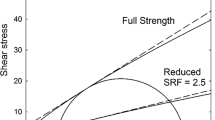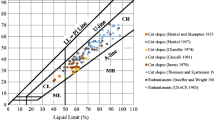A non-equal strength reduction technique for slope stability analysis is developed that considers the progressive failure characteristics of soils with strain-softening behavior. The method assumes that the soil’s cohesion and friction angle decrease from peak to residual strength along different paths during shear failure. A relationship between the reduction factors of the cohesion and friction angle is derived, and a calculation code is compiled based on a finite difference program. Sensitivity analysis shows that the attenuation interval coefficient has little effect on the calculation results. The factor of safety obtained by this method lies between the traditional strength reduction and limit equilibrium methods. Finally, the selection of failure criteria in slope limit analysis using numerical modelling is discussed.
Similar content being viewed by others
References
O. C. Zienkiewicz, C. Humpheson, and R. W. Lewis, “Associated and non-associated visco-plasticity and plasticity in soil mechanics,” Geotechnique, 25(4), 671–689 (1975).
D. V. Griffiths and P. A. Lane, “Slope stability analysis by finite elements,” Geotechnique, 49(3), 387–403 (1999).
E. M. Dawson, W. H. Roth, and A. Drescher, “Slope stability analysis by strength reduction,” Geotechnique, 49(6), 835–840 (1999).
F. Tschuchnigg, H. F. Schweiger, and S. W. Sloan, “Slope stability analysis by means of finite element limit analysis and finite element strength reduction techniques. Part II: Back analyses of a case history,” Comput. Geotech., 70, 178–189 (2015).
E. Eberhardt, D. Stead, and J. S. Coggan, “Numerical analysis of initiation and progressive failure in natural rock slopes—the 1991 Randa rockslide,” Int. J. Rock Mech. Min. Sci., 41(1), 69–87 (2010).
A. K. Alzo’ubi, “The effect of tensile strength on the stability of rock slopes,” Ph.D. thesis, University of Alberta, Edmonton, Canada (2009).
G. Q. Chen, R. Q. Huang, Q. Xu, T. B. Li, and M. L. Zhu, “Progressive modelling of the gravity-induced landslide using the local dynamic strength reduction method,” J. Mt. Sci., 10(4), 532–540 (2013).
F. Tang, Y. R. Zheng, and S. Y. Zhao, “Discussion on two safety factors for progressive failure of soil slope,” Chin. J. Rock Mech. Eng., 26(7), 1402–1407 (2007).
W. Yuan, B. Bai, X. C. Li, and H. B. Wang, “A strength reduction method based on double reduction parameters and its application,” J. Cent. South Univ., 20(9), 2555–2562 (2013).
H. B. Xue, F. N. Dang, X. T. Yin, W. H. Ding, and C. Yang, “Nonproportional correlative reduction finite element method for slope strength parameters,” Math. Probl. Eng., 1–10 (2016).
D. P. Deng, and L. Li, “Limit equilibrium analysis of slope stability with coupling nonlinear strength criterion and double-strength reduction technique,” Int. J. Geomech., 19(6),04019052 (2019).
E. Conte, F. Silvestri, and A. Troncone, “Stability analysis of slopes in soils with strain-softening behavior,” Comput. Geotech., 37(5), 710–722 (2010).
K. Terzaghi and R. B. Peck, Soil Mechanics in Engineering Practice, Wiley, New York (1948).
N. Barton, “A model study of the behaviour of steep excavated rock slopes,” Ph.D. thesis, University of London, London, UK (1971).
A. W. Skempton, “Long term stability of clay slopes,” Geotechnique, 14(1), 77–101 (1964).
J. P. Carter and S. K. Yeung, “Analysis of cylindrical cavity expansion in a strain weakening material,” Comput. Geotech., 1(3): 161–180 (1985).
Itasca Consulting Group, FLAC3D, Fast Lagrangian Analysis of Continua in 3 Dimensions. User’s Guide, Itasca Consulting Group, Minneapolis (2013).
D. Park and R. L. Michalowski, “Three-dimensional stability analysis of slopes in hard soil/soft rock with tensile strength cut-off,” Eng. Geol., 229(7), 73–84 (2017).
Author information
Authors and Affiliations
Corresponding author
Additional information
Translated from Osnovaniya, Fundamenty i Mekhanika Gruntov, No. 4, July-August, 2021.
Rights and permissions
About this article
Cite this article
An, X., Li, N. Non-Equal Strength Reduction Analysis of Soil Slopes Considering Progressive Failure. Soil Mech Found Eng 58, 273–279 (2021). https://doi.org/10.1007/s11204-021-09739-7
Published:
Issue Date:
DOI: https://doi.org/10.1007/s11204-021-09739-7




